How to get rid of condensate on the pipes
Condensate is a common cold water problem. In this article we will explain how to get rid of condensate on pipes, consider the reasons for its occurrence and list the measures to prevent trouble.
Before you begin maintenance work or begin to take drastic measures, you need to identify the causes of condensate.
Why is this happening?
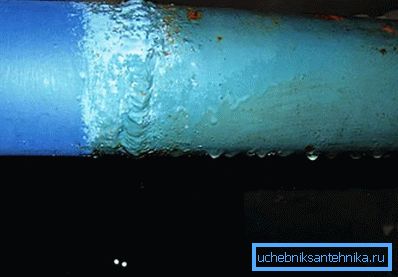
The first reason may be the lack of ventilation or its insufficiently effective work. You can check the operation of ventilation by attaching a small sheet of paper to the exhaust window. If it holds, the hood works well.
Tip! Leaking water from the pipe can cause a leak in the top of your pipes and your neighbors.
Finding out why condensation appears on the pipes, check for leakage of the drain tank. If he passes water through himself, then she, not having time to warm up to room temperature, is constantly replaced by cold. This cools the pipe, resulting in droplets on the surface.
Ways to combat the formation of condensate
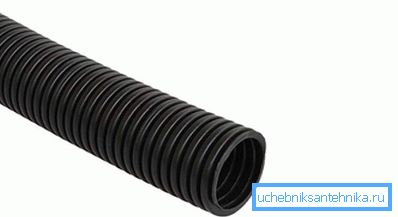
To help in the fight against condensate will help thermal insulation layer. This option will reliably and permanently save you from such manifestations. In order not to purchase expensive material, you can use mounting foam. Consider the process of such thermal insulation:
- Corrugated or thick cardboard cut into small pieces (slightly larger than the volume of the pipe).
- Then they need to be put on the problem area along the entire length. You can connect the segments with scotch tape.
- Then the space between the cardboard and the tube is filled with mounting foam.
Another option for thermal insulation of pipes
For the work we need:
- Sandpaper.
- Rust converter
- Thick thread or tape.
- Thick fabric.
- Epoxy putty.
- Putty knife.
- Acetone.
Installation instructions for homemade thermal insulation
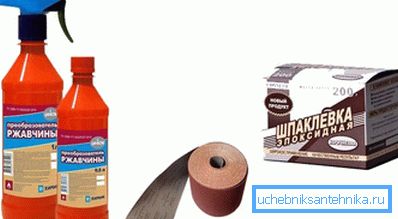
First, sandpaper must sand the entire surface of the pipe to ensure the adhesion of the material.
Tip! If the work is carried out on plastic pipes, you can not overdo it with stripping. It is better to use fine sandpaper for this.
After that, the surface is degreased with a cloth moistened with acetone and treated with a rust converter. When the pipe is dry, it is necessary to apply an even layer of epoxy putty on its surface.
Tip! Be sure to make sure that it is the necessary consistency. Liquid will drain from the pipe. Thick as difficult to spread over the surface.
While the material has not hardened, carefully wrap the pipe with a cloth with a slight stretch, but only so that the putty does not flow out of the seams. When wrapping, try to make turns with a small margin (1 cm). When the winding layer is well fixed, it is necessary to wind several fabric layers on it and process it again with epoxy. After drying, the surface is polished and painted in the desired color.
Use of specialized material

The easiest option - the purchase of factory insulation, widely represented on the market. In particular, it is recommended to use the following materials:
- Penofol.
- Enegoflex.
- Polypropylene.
- Basalt insulation, etc.
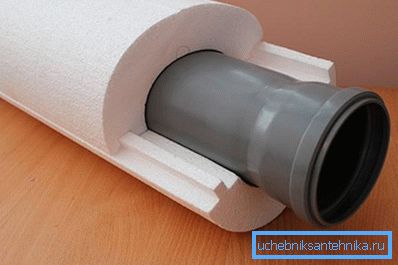
Tip! All heaters are manufactured in accordance with the size of the pipes. They consist of two halves, which are conveniently mounted on problem areas of the pipeline.
Cold Water Condensate
If you have condensation on the cold water pipes in the bathroom or toilet, then the primary cause of its appearance is insufficient ventilation. In this case, it will manifest itself not only on the water supply pipe, but, for example, on the drain tank.
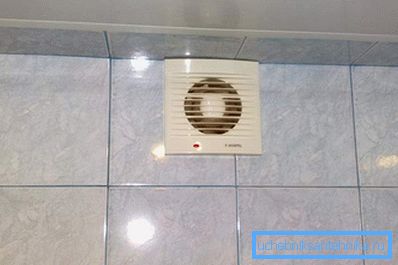
What to do? First make sure that the ventilation is working properly. It can also cause mold and mildew, which contributes to the manifestation of respiratory diseases.
If ventilation functions normally, but this is not enough, you can install an exhaust fan in the duct.
Gas boiler tubes
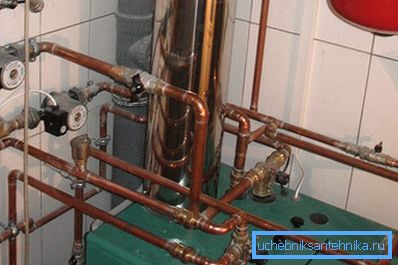
If condensate appears on the pipes of a gas boiler, then it should immediately be noted that it cannot be completely removed. But to reduce his education is possible, following the above tips.
The design of the gas pipe and the material from which it will be made must strictly comply with regulatory requirements.
To reduce the cooling time of the pipe it is necessary to warm it, especially the upper part.
Auxiliary measures
Typically, the methods described above help prevent the formation of water droplets on the surface of pipes. But what to do with condensate, if all of these methods did not have the desired effect?
In this case, measures are taken to improve the natural circulation of air in the house. But first identify the places where you need to spend work. Reasons for the formation of moisture can be:
- Basement evaporation.
- Wet foundation.
- Poor thermal insulation.
First you need to identify the problem, and then you can begin to fix it.
Climate impact
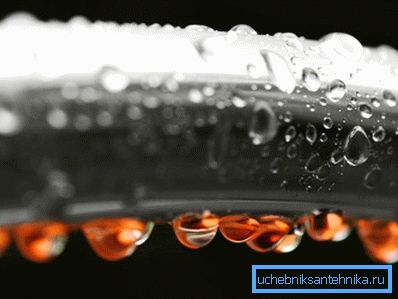
In addition to increased humidity and the lack of a heat-insulating layer, some external factors can affect the formation of condensate:
- Protracted rains.
- The presence of a reservoir near the building.
- Features of the area.
In this case, the above methods will be useless. Here you will need to change the internal climate of the room. This will help:
- Installation of air conditioning or split system.
- Acquisition of moisture absorber.
That, in principle, is all that can be said about the formation of condensate, as well as ways to combat it. With the right approach, you can reliably protect yourself from this manifestation and all its negative consequences.
Video
This video clearly shows how important it is to warm the pipes to prevent condensation.